SUMF1
| SUMF1 | |||||||||||||||||||||||||||||||||||||||||||||||||||
|---|---|---|---|---|---|---|---|---|---|---|---|---|---|---|---|---|---|---|---|---|---|---|---|---|---|---|---|---|---|---|---|---|---|---|---|---|---|---|---|---|---|---|---|---|---|---|---|---|---|---|---|
 | |||||||||||||||||||||||||||||||||||||||||||||||||||
| |||||||||||||||||||||||||||||||||||||||||||||||||||
| Identifiers | |||||||||||||||||||||||||||||||||||||||||||||||||||
| Aliases | SUMF1, AAPA3037, FGE, UNQ3037, sulfatase modifying factor 1 | ||||||||||||||||||||||||||||||||||||||||||||||||||
| External IDs | OMIM: 607939; MGI: 1889844; HomoloGene: 16268; GeneCards: SUMF1; OMA:SUMF1 - orthologs | ||||||||||||||||||||||||||||||||||||||||||||||||||
| |||||||||||||||||||||||||||||||||||||||||||||||||||
| |||||||||||||||||||||||||||||||||||||||||||||||||||
| |||||||||||||||||||||||||||||||||||||||||||||||||||
| |||||||||||||||||||||||||||||||||||||||||||||||||||
| |||||||||||||||||||||||||||||||||||||||||||||||||||
| Wikidata | |||||||||||||||||||||||||||||||||||||||||||||||||||
| |||||||||||||||||||||||||||||||||||||||||||||||||||
Sulfatase-modifying factor 1 is an enzyme that in humans is encoded by the SUMF1 gene.[5][6][7]
Sulfatases catalyze the hydrolysis of sulfate esters such as glycosaminoglycans, sulfolipids, and steroid sulfates. C-alpha-formylglycine (FGly), the catalytic residue in the active site of eukaryotic sulfatases, is posttranslationally generated from a cysteine by SUMF1, the human form of the aerobic Formylglycine-generating enzyme (FGE), in the endoplasmic reticulum (ER). The genetic defect of FGly formation caused by mutations in the SUMF1 gene results in inactive FGE, and subsequently multiple sulfatase deficiency (MSD; MIM 272200), a lysosomal storage disorder (Roeser et al., 2006).[supplied by OMIM][7]
References
- ^ a b c GRCh38: Ensembl release 89: ENSG00000144455 – Ensembl, May 2017
- ^ a b c GRCm38: Ensembl release 89: ENSMUSG00000030101 – Ensembl, May 2017
- ^ "Human PubMed Reference:". National Center for Biotechnology Information, U.S. National Library of Medicine.
- ^ "Mouse PubMed Reference:". National Center for Biotechnology Information, U.S. National Library of Medicine.
- ^ Dierks T, Schmidt B, Borissenko LV, Peng J, Preusser A, Mariappan M, von Figura K (May 2003). "Multiple sulfatase deficiency is caused by mutations in the gene encoding the human C(alpha)-formylglycine generating enzyme" (PDF). Cell. 113 (4): 435–444. doi:10.1016/S0092-8674(03)00347-7. PMID 12757705. S2CID 11571659.
- ^ Cosma MP, Pepe S, Annunziata I, Newbold RF, Grompe M, Parenti G, Ballabio A (May 2003). "The multiple sulfatase deficiency gene encodes an essential and limiting factor for the activity of sulfatases". Cell. 113 (4): 445–456. doi:10.1016/S0092-8674(03)00348-9. PMID 12757706. S2CID 15095377.
- ^ a b "Entrez Gene: SUMF1 sulfatase modifying factor 1".
Further reading
- Strausberg RL, Feingold EA, Grouse LH, et al. (2003). "Generation and initial analysis of more than 15,000 full-length human and mouse cDNA sequences". Proc. Natl. Acad. Sci. U.S.A. 99 (26): 16899–16903. Bibcode:2002PNAS...9916899M. doi:10.1073/pnas.242603899. PMC 139241. PMID 12477932.
- Clark HF, Gurney AL, Abaya E, et al. (2003). "The Secreted Protein Discovery Initiative (SPDI), a Large-Scale Effort to Identify Novel Human Secreted and Transmembrane Proteins: A Bioinformatics Assessment". Genome Res. 13 (10): 2265–2270. doi:10.1101/gr.1293003. PMC 403697. PMID 12975309.
- Ota T, Suzuki Y, Nishikawa T, et al. (2004). "Complete sequencing and characterization of 21,243 full-length human cDNAs". Nat. Genet. 36 (1): 40–45. doi:10.1038/ng1285. PMID 14702039.
- Cosma MP, Pepe S, Parenti G, et al. (2004). "Molecular and functional analysis of SUMF1 mutations in multiple sulfatase deficiency". Hum. Mutat. 23 (6): 576–581. doi:10.1002/humu.20040. PMID 15146462. S2CID 44637380.
- Gerhard DS, Wagner L, Feingold EA, et al. (2004). "The Status, Quality, and Expansion of the NIH Full-Length cDNA Project: The Mammalian Gene Collection (MGC)". Genome Res. 14 (10B): 2121–2127. doi:10.1101/gr.2596504. PMC 528928. PMID 15489334.
- Preusser-Kunze A, Mariappan M, Schmidt B, et al. (2005). "Molecular characterization of the human Calpha-formylglycine-generating enzyme". J. Biol. Chem. 280 (15): 14900–14910. doi:10.1074/jbc.M413383200. PMID 15657036.
- Dierks T, Dickmanns A, Preusser-Kunze A, et al. (2005). "Molecular basis for multiple sulfatase deficiency and mechanism for formylglycine generation of the human formylglycine-generating enzyme" (PDF). Cell. 121 (4): 541–552. doi:10.1016/j.cell.2005.03.001. PMID 15907468. S2CID 2956795.
- Otsuki T, Ota T, Nishikawa T, et al. (2007). "Signal sequence and keyword trap in silico for selection of full-length human cDNAs encoding secretion or membrane proteins from oligo-capped cDNA libraries". DNA Res. 12 (2): 117–126. doi:10.1093/dnares/12.2.117. PMID 16303743.
- Roeser D, Preusser-Kunze A, Schmidt B, et al. (2006). "A general binding mechanism for all human sulfatases by the formylglycine-generating enzyme". Proc. Natl. Acad. Sci. U.S.A. 103 (1): 81–86. Bibcode:2006PNAS..103...81R. doi:10.1073/pnas.0507592102. PMC 1324989. PMID 16368756.
- Fraldi A, Biffi A, Lombardi A, et al. (2007). "SUMF1 enhances sulfatase activities in vivo in five sulfatase deficiencies". Biochem. J. 403 (2): 305–312. doi:10.1042/BJ20061783. PMC 1874239. PMID 17206939.
- Annunziata I, Bouchè V, Lombardi A, et al. (2007). "Multiple sulfatase deficiency is due to hypomorphic mutations of the SUMF1 gene". Hum. Mutat. 28 (9): 928. doi:10.1002/humu.9504. PMID 17657823. S2CID 8500605.
- v
- t
- e
-
 1y1e: human formylglycine generating enzyme
1y1e: human formylglycine generating enzyme -
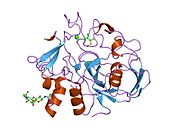 1y1f: human formylglycine generating enzyme with cysteine sulfenic acid
1y1f: human formylglycine generating enzyme with cysteine sulfenic acid -
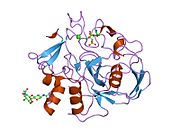 1y1g: human formylglycine generating enzyme, double sulfonic acid form
1y1g: human formylglycine generating enzyme, double sulfonic acid form -
 1y1h: human formylglycine generating enzyme, oxidised Cys refined as hydroperoxide
1y1h: human formylglycine generating enzyme, oxidised Cys refined as hydroperoxide -
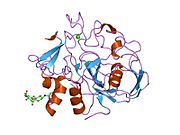 1y1i: hyuman formylglycine generating enzyme, reduced form
1y1i: hyuman formylglycine generating enzyme, reduced form -
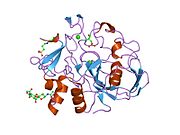 1y1j: human formylglycine generating enzyme, sulfonic acid/desulfurated form
1y1j: human formylglycine generating enzyme, sulfonic acid/desulfurated form -
 1z70: 1.15A resolution structure of the formylglycine generating enzyme FGE
1z70: 1.15A resolution structure of the formylglycine generating enzyme FGE -
 2aft: Formylglycine generating enzyme C336S mutant
2aft: Formylglycine generating enzyme C336S mutant -
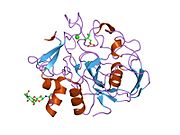 2afy: Formylglycine generating enzyme C341S mutant
2afy: Formylglycine generating enzyme C341S mutant -
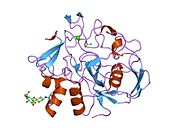 2aii: wild-type Formylglycine generating enzyme reacted with iodoacetamide
2aii: wild-type Formylglycine generating enzyme reacted with iodoacetamide -
 2aij: Formylglycine generating enzyme C336S mutant covalently bound to substrate peptide CTPSR
2aij: Formylglycine generating enzyme C336S mutant covalently bound to substrate peptide CTPSR -
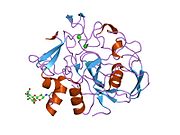 2aik: Formylglycine generating enzyme C336S mutant covalently bound to substrate peptide LCTPSRA
2aik: Formylglycine generating enzyme C336S mutant covalently bound to substrate peptide LCTPSRA -
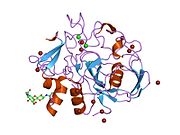 2hi8: human formylglycine generating enzyme, C336S mutant, bromide co-crystallization
2hi8: human formylglycine generating enzyme, C336S mutant, bromide co-crystallization -
 2hib: human formylglycine generating enzyme, C336S mutant, iodide co-crystallization
2hib: human formylglycine generating enzyme, C336S mutant, iodide co-crystallization
 | This article on a gene on human chromosome 3 is a stub. You can help Wikipedia by expanding it. |
- v
- t
- e






























